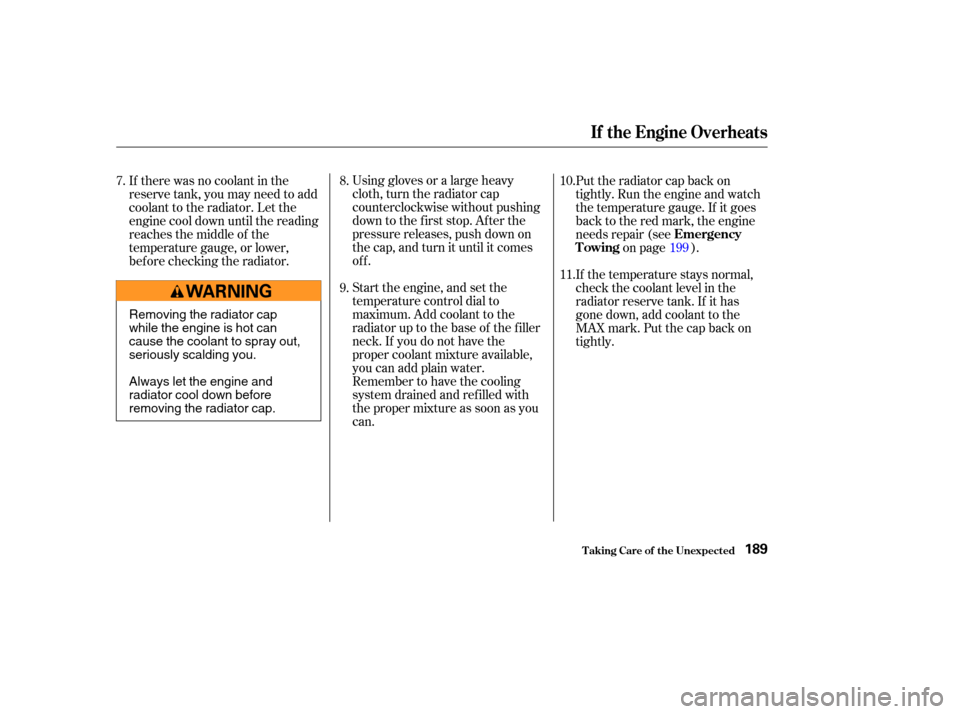Page 50 of 231
These labels are in the locations
shown. They warn you of potential
hazards that could cause serious
injury. Read these labels caref ully. If
a label comes of f or becomes hard to
read, contact your Honda dealer f or
a replacement.
CONT INUED
U.S. modelsCanadian models
U.S. models only
Saf ety L abels
Driver and Passenger Saf ety47
RADIATOR CAP SUN VISOR
DASHBOARD
Page 154 of 231
Fluid Locations
Maint enance151
RADIATOR CAP
ENGINE OIL DIPSTICK
(Orange loop)
ENGINE OIL
FILL CAP
CONTINUOUSLY VARIABLE TRANSMISSION (CVT)
FLUID DIPSTICK (Yellow loop) BRAKE FLUID
(Gray cap)
WASHER FLUID
(Blue cap)
ENGINE COOLANT
RESERVOIR CLUTCH FLUID
(Manual Transmission only)
(Gray cap)
Page 159 of 231

If the reserve tank is completely
empty, you should also check the
coolant level in the radiator.When the radiator and engine are
cool, relieve any pressure in the
cooling system by turning the
radiator cap counterclockwise,
without pressing down.
Remove the radiator cap by
pushing down and turning
counterclockwise.The coolant level should be up to
the base of the f iller neck. Add
coolant if it is low.
Pour the coolant slowly and
caref ully so you do not spill. Clean
up any spill immediately; it could
damage components in the engine
compartment.
Put the radiator cap back on and
tighten it.
Pour coolant into the reserve tank.
Fill it to half way between the MAX
and MIN marks. Put the cap back
on the reserve tank.
Do not add any rust inhibitors or
other additives to your vehicle’s
cooling system. They may not be
compatible with the coolant or
engine components.
1.
2. 3.
4.
5.
Engine Coolant
Maint enance156
RADIATOR CAP
Removing the radiator cap
while the engine is hot can
cause the coolant to spray out,
seriously scalding you.
Always let the engine and
radiator cool down before
removing the radiator cap.
Page 192 of 231

Using gloves or a large heavy
cloth, turn the radiator cap
counterclockwise without pushing
down to the first stop. After the
pressure releases, push down on
the cap, and turn it until it comes
off.
Start the engine, and set the
temperature control dial to
maximum. Add coolant to the
radiator up to the base of the f iller
neck. If you do not have the
proper coolant mixture available,
you can add plain water.
Remember to have the cooling
system drained and ref illed with
the proper mixture as soon as you
can.Put the radiator cap back on
tightly. Run the engine and watch
the temperature gauge. If it goes
back to the red mark, the engine
needs repair (see
on page ).
If the temperature stays normal,
check the coolant level in the
radiator reserve tank. If it has
gone down, add coolant to the
MAX mark. Put the cap back on
tightly.
If there was no coolant in the
reserve tank, you may need to add
coolant to the radiator. Let the
engine cool down until the reading
reaches the middle of the
temperature gauge, or lower,
bef ore checking the radiator.
8.
9. 10.
11.
7.
199
If theEngineOverheats
T aking Care of t he Unexpect ed
Emergency
Towing
189
Removing the radiator cap
while the engine is hot can
cause the coolant to spray out,
seriously scalding you.
Always let the engine and
radiator cool down before
removing the radiator cap.